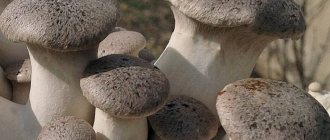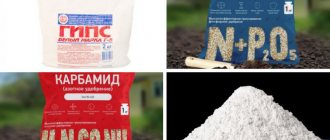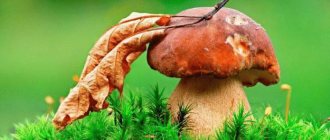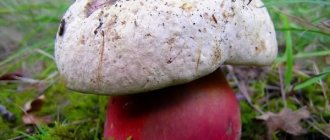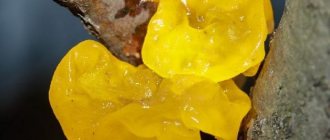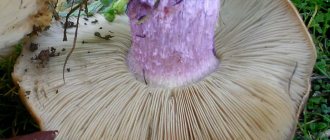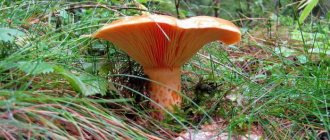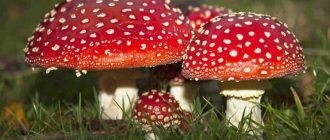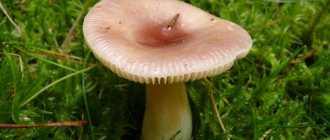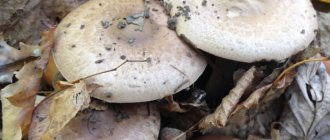Short description
| Type of mushrooms: | Edible |
| Other names (synonyms): | Eringi, Steppe oyster mushroom |
| Latin name: | Pleurotus eryngii |
| Family: | Oyster mushrooms (Pleurotaceae) |
| Distinctive feature: | The royal oyster mushroom is an edible mushroom, and one of the most delicious and well cultivated. In terms of the content of valuable substances, the oyster mushroom is close to meat and dairy products and surpasses all vegetable crops (except legumes). |
| Beginning of the season: | August |
| End of season: | november |
| Leg height (cm): | 2-4 cm |
| Cap width (cm): | 5-10 cm |
| Smell: | mushroom |
| Taste: | soft, pleasant |
| Tasting score: | [kkstarratings] Have you tried this mushroom? Then rate it! |
| Hat: | at an early age with a tubercle in the center, then it becomes flat and even depressed, fleshy. The color of the skin is first red-brown, then brownish to pale ocher, becoming paler towards the edges. The surface, especially in the center, is finely scaly or fibrous. |
| Leg: | central or eccentric, cylindrical, thickened at the base, whitish, then brownish-ochreous, often cottony in old mushrooms. |
| Hymenophore (bottom of cap): | the plates descending onto the stem, quite frequent, pinkish-cream in color, with an equally colored solid edge. |
| Disputes: | whitish, cylindrical-elliptical in shape, 9-13.2 x 4.3-5.7 microns. |
| Pulp: | whitish, sometimes brownish or pinkish. |
| Natural environment and mycorrhiza: | forms colonies on the roots and stems of umbrella plants from the genera Eryngium, Ferula, Ferulnik, Gladysh, Tapsia. |
| False doubles: | it resembles a champignon and a real milk mushroom, although its flesh is somewhat coarser, but the taste is the same. |
| Growing: | often grown in artificial mushroom farms. |
| Use: | edible - only young ones. |
| Medicinal properties: | has antioxidants that help keep disease at bay. The antioxidant in this mushroom comes in the form of an amino acid known as ergothioneine. Some sources also report that the mushroom Pleurotus Eryngii has antibacterial properties. |
| Spreading: | in southern Russia, North America, Central Asia and Europe |
Yeringi is rightfully considered one of the best species, not only due to its excellent taste and medicinal properties. The white steppe mushroom can be successfully grown at home, bred and even make an income. Royal oyster mushroom is very similar in taste to white mushroom and champignon, and in nutritional value it even surpasses some vegetables and meat. Find out everything about how to grow eringi, what you can prepare from this wonderful representative of the mushroom kingdom.
Nutritional Value and Health Benefits
Eringa mushrooms are a hearty gift from the steppe grass.
Oyster mushrooms are widely known edible and tasty mushrooms. This also applies to their steppe variety. Eringa mushrooms contain many useful substances, not inferior in the degree of richness to meat and dairy products, and in terms of these characteristics are superior to most vegetables, except legumes. The content of easily digestible proteins in them reaches 25%. The presence of polyunsaturated fatty acids in Yeringa mushrooms allows, when consumed as food, to resist the development of atherosclerosis and the accumulation of cholesterol in the blood. They also contain polysaccharides, ascorbic acid and the entire complex of B vitamins, which have antitumor and immunomodulatory effects.
Eringa mushrooms - a hearty gift from steppe grass
Constant consumption of oyster mushrooms allows you to:
- Restore the body's resources - steppe oyster mushroom contains a lot of proteins and carbohydrates and is quite high in calories, due to which it contributes to the process of energy restoration.
- Strengthen the central nervous system.
- Increase the level of hemoglobin - due to the content of iron, ascorbic and folic acids, necessary for the normal implementation of the hematopoiesis process.
- Help improve vision.
- Reduce the risk of developing malignant tumors.
- Normalize blood pressure, the functioning of the heart and blood vessels - oyster mushroom takes care of the heart, protecting it from arrhythmia, ischemia, heart attack and angina.
- Normalize digestive processes - due to the presence of valuable dietary fiber, the mushroom helps with colitis, gastritis, bloating, flatulence and constipation.
- Strengthen tooth enamel due to the presence of calcium and phosphorus, which protect against the development of caries, gingivitis, periodontal disease and stomatitis.
- Protect eye health - due to the presence of a large amount of fatty acids, consumption of Yeringa mushrooms helps prevent the development of cataracts and retinal dystrophy.
- Promote the process of calcium absorption in the body.
- Help the process of removing cholesterol from the body due to the content of lovastatin.
- Cleanse the body of radionuclides.
- Rids the body of toxins and waste, due to the fact that the mushroom pulp acts as a powerful absorbent.
Eringa mushrooms - a hearty gift from steppe grass
Vitamin composition:
- B1, thiamine – 0.08 mg.
- B2, riboflavin – 0.5 mg.
- B5, pantothenic acid – 1.8 mg.
- B6, pyridoxine – 0.07 mg.
- B9, folic acid – 52 mcg.
- C, ascorbic acid – 27 mg.
- E, alpha – tocopherol, TE – 0.9 mg.
- PP, nicotinic acid – 8.3 mg.
The pulp of Yeringa mushrooms is very well absorbed by the body, is quickly digested and does not create a feeling of heaviness in the stomach. It is suitable as part of a dietary menu for those wishing to lose excess weight, or for patients with diabetes, and also as a substitute for meat and fish in vegetarian or lenten dishes.
Eringa mushrooms - a hearty gift from steppe grass
The range of dishes that can be prepared using Steppe Oyster Mushroom is huge - from salads with Korean carrots to exquisite French soups. They are good both boiled and fried, as well as in a variety of pickles.
Composition, medicinal properties
As we noted earlier, steppe oyster mushroom is considered a very useful mushroom. The pulp of the fruit consists of a large amount of protein, amino acids, iron, calcium, copper, vitamins B, PP, C and other useful elements. Experts compare oyster mushrooms with meat or full-fledged vegetable products, which is beneficial for vegetarians, as well as those who adhere to health-improving, “weight-loss” diets. A small amount of delicacy is enough to satisfy your hunger, while its calorie content is minimal.
If we consider the mushroom under the prism of its effect on the human body, the fruits are recommended for food:
- People with cardiovascular diseases;
- For those who want to cleanse their body of cholesterol;
- Suffering from diabetes;
- Patients with atherosclerosis, tumor diseases;
- People with kidney or liver diseases;
- For inflammatory processes, anemia.
Description and distribution locations of the steppe oyster mushroom (royal)
It turns out that porcini mushrooms can grow not only in the forest. But we are not talking about the fat one, which we consider the most delicious and nutritious type. The fact is that steppe oyster mushroom is also called porcini mushroom, but only steppe mushroom, and it looks completely different. Where does this beauty grow, can it be eaten?
Description
Steppe oyster mushroom (Pleurotus eryngii), also called “steppe porcini mushroom”, is a lamellar representative of the mushroom kingdom, belonging to the Oyster family, genus Oyster mushroom. This edible beauty can also be called eringi, royal oyster mushroom, white steppe or simply steppe mushroom.
- the cap is quite thick, of medium size, from 4 to 8 cm in diameter, but sometimes it can grow up to 13-25 cm. In young royal oyster mushrooms, it is slightly convex, with a tubercle in the central part, but over time it becomes flat or funnel-shaped with irregularly shaped edges . The surface is smooth to the touch with a small number of small scales - most of them are in the central part. The skin color ranges from dark brown to cream shades. As the mushroom matures, the dark cap becomes lighter: first red-brown, then brownish, and even later pale ocher. In the middle, as a rule, the color is brighter and more saturated, paler towards the edges;
- the leg is low, up to 5 cm, but thick and dense, up to 2.5 cm wide, widening downward. It has a cylindrical shape, usually located in the center of the cap. The color of the skin is whitish, darkening with age;
- the flesh is thick and fleshy, dense, but in old mushrooms the stem often becomes cottony. The color is white, may be slightly pinkish or have a brown tint. The taste is pronounced mushroom, but the pulp does not have a special smell;
- the plates are moderately frequent, but wide, slightly descending along the stem. They are pinkish-white or cream in color;
- The spores are creamy, in the shape of narrow ellipses or small cylinders.
Distribution and fruiting period
Yeringi (Eringi) mushrooms grow in the wild where it is relatively warm - in southern Russia, North America, Central Asia and Europe. They are found in pastures and deserts on plant debris, stems, and roots of umbrella plant species - these are ferula, eryngium, gladysh and others.
The steppe oyster mushroom or white steppe mushroom bears fruit only in the spring, appearing in the southern regions as early as March and April. Prone to parasitism and often acts as a saprophyte.
Edibility
The white steppe mushroom is considered a very valuable and tasty representative of the mushroom kingdom. The taste is reminiscent of real milk mushrooms or champignons, but a little tougher.
You can make delicious homemade preparations from it - it is suitable for pickling, salting, and consumed fresh (after minimal heat treatment).
Note that steppe oyster mushroom is very rich in proteins - it contains approximately 15-25%, and during heat treatment their amount increases to 70%. At the same time, they are perfectly absorbed by the human body. In terms of the content of other nutrients and beneficial substances, the composition of the pulp is close to meat and dairy products.
The pulp of the steppe oyster mushroom is also good for health - it contains acids that lower cholesterol levels and prevent the development of atherosclerosis. It is rich in ascorbic acid, B vitamins, has antitumor properties and improves immunity.
Growing
Since the royal oyster mushroom is rightfully considered one of the most delicious species, it has been cultivated for a long time. And it is much easier to grow than champignons, since it is unpretentious to growing conditions and has high yields.
Steppe oyster mushroom is grown on a pasteurized substrate using block production technology. In special bags, the mycelium develops quickly - it only takes 3 weeks.
Optimal growing conditions are air temperature about 18-25 degrees, humidity about 90%. After the first rudiments of mushrooms appear, it is reduced to 80%.
In order for oyster mushrooms to bear fruit better, use a covering soil, which is applied in a 3 cm layer to a block with the rudiments of mushrooms that have already appeared.
If you have the opportunity, be sure to try the steppe oyster mushroom - it is a tasty and nutritious mushroom. Fortunately, now you don’t need to travel far away to find it - you can simply buy a package of steppe mushrooms in a store and appreciate their taste.
Recipes
Eringi is such a versatile mushroom that you can cook almost any dish with its participation; its taste will not spoil at all, but, on the contrary, will be emphasized by this amazing steppe guest.
In Korean
This oyster mushroom recipe meets all the rules of Korean cuisine. Sweet and sour marinade made from soy sauce and honey has become incredibly popular lately. It can be used not only in this recipe, but also when creating other mushroom, vegetable, and meat dishes.
Ingredients:
- oyster mushroom – 300 g;
- soy sauce – 2 tbsp. l.;
- lemon juice – 1 tbsp. l.;
- honey – 2 tbsp. l.;
- vegetable oil – 60 ml;
- sesame seeds, salt - to taste.
Cooking method:
- Fry some sesame seeds in a dry frying pan until a slight nutty smell appears.
- In a deep container, mix honey, soy sauce, oil, lemon juice. Beat well.
- Place the eringa pieces in the marinade for 20 minutes.
- Fry the mushrooms in a dry frying pan, stirring constantly so as not to burn.
- Finally, pour in the remaining marinade and simmer for 2-3 minutes until the sauce thickens.
- Serve the dish with vegetables or rice noodles.
In Chinese
Spicy, piquant erings in sweet and sour sauce will appeal to even sophisticated gourmets. This dish is perfect for a holiday table.
Ingredients:
- mushrooms – 200 g;
- chili sauce – 50 ml;
- lime juice – 2 tbsp. l.;
- rice vinegar – 1 tsp;
- soy sauce – 50 ml;
- sesame oil – 30 ml;
- green onions, sesame seeds (optional).
Cooking method:
- Prepare a sauce from lime juice, sesame oil, vinegar, 2 types of sauces.
- Finely chop the green onion stems.
- Peel the eringi and cut into thin slices.
- Dip each piece in the sauce and fry in a frying pan with a little oil.
- Serve on a flat platter with chopped onion and sesame seeds.
Mushroom cream soup
A delicate, aromatic soup made from royal oyster mushrooms will certainly delight you and your loved ones with its taste. To give it a silky consistency, it is worth adding cream with a high percentage of fat content.
Ingredients:
- eringi – 300 g;
- potatoes – 400 g;
- salt – 1 tbsp. l.;
- cream – 200 ml;
- butter – 30 g;
- green onions and dill.
Cooking method:
- Peel the oyster mushrooms, cut into slices and fry in a frying pan with a little oil until golden brown.
- Peel the potatoes and cut them into bars.
- Place the vegetable in a saucepan of boiling water and cook until tender.
- Add mushrooms to the soup, add salt and season.
- At the very end of cooking, pour in the cream and simmer for another 5 minutes.
- Using a blender, give the liquid a creamy consistency.
- Sprinkle each serving of soup with chopped herbs.
Pasta with mushrooms
This tasty, aromatic dish will come in handy during Lent, for a vegetarian diet. It is very important to cook the pasta until al dente (to the tooth) so that the treat retains its shape and consistency.
Ingredients:
- carrots, onions - 1 pc.;
- sweet pepper – 1 pc.;
- royal oyster mushroom – 200 g;
- tomatoes – 3 pcs.;
- pasta, macaroni – 200 g;
- salt, pepper - to taste;
- butter – 30 g;
- basil, parmesan cheese - for serving.
Cooking method:
- Boil a large amount of water in a deep container and add salt. Cook the pasta in the traditional way. Drain in a colander.
- Peel the vegetables. Cut the onion into cubes, chop the carrots into thin strips.
- Vegetables need to be fried until soft.
- Peel the eringi and cut into slices of any size.
- Fry in butter until tender, remove from the pan and transfer to another container.
- Sauté thinly sliced peppers and tomatoes in the same oil.
- Combine all the vegetables and mushrooms in one container, season to taste with spices and salt. Simmer for another 5 minutes.
- Serve the treat at the table like this: put the pasta on a plate, form it into a nest, inside which place the fried mushrooms and vegetables.
- Sprinkle with basil and Parmesan cheese.
Salad
This salad has only 6 ingredients, and it will take you no more than 15 minutes to prepare.
Prepare a warm salad with king oyster mushrooms to surprise your guests! Ingredients:
- sweet pepper – 1 pc.;
- thyme – 6-7 sprigs;
- potatoes - 2 tubers;
- eringi – 200 g;
- zucchini - half a zucchini;
- garlic, salt - to taste.
Cooking method:
- Fry the pre-peeled and sliced eryingi over medium heat.
- Peel the potatoes, cut into cubes and fry in the same pan until cooked.
- At the very end of frying, place thyme sprigs and crushed garlic in a container.
- Zucchini and bell pepper should be cut into cubes and added to the rest of the ingredients.
- Mix thoroughly, season with salt and spices. Serve warm.
Spicy paste
Try preparing a delicious, aromatic dish with buckwheat paste. In addition to the maximum benefits from vegetables and mushrooms, you will also receive aesthetic pleasure from contemplating a bright, colorful dish.
Ingredients:
- buckwheat paste – 250 g;
- eringi – 500 g;
- sweet pepper (not hot) – 1 pc.;
- green beans – 200 g;
- tomato paste – 30 g;
- garlic – 2 cloves;
- salt, pepper - to taste;
- vegetable oil for frying.
Cooking method:
- Cook the pasta until half cooked, drain in a colander.
- Peel the mushrooms and fry them in a small amount of oil until golden brown.
- Cut the pepper into thin strips.
- Place vegetables (peppers, beans) in a frying pan with oyster mushrooms, cover with a lid and simmer for 4-5 minutes.
- Add tomato paste, add a little water, season with spices and chopped garlic. Cook for another 5 minutes.
- Mix pasta with vegetable dressing.
Fried eringi in batter
To prepare a delicious snack according to this recipe you will need the following ingredients:
- eringi – 500 g;
- egg – 1 pc.;
- flour – 100 g;
- salt, pepper - a pinch;
- vegetable oil for frying.
Cooking method:
- Slice the king oyster mushrooms along with their caps lengthwise.
- Prepare the egg batter: beat it thoroughly with a fork, add salt and pepper.
- Dip each mushroom slice in flour, then in batter and fry in vegetable oil until tender.
- It is better to place the golden brown slices directly on a paper towel to drain the fat.
Royal Oyster mushroom with potatoes
Learn how to fry a familiar dish from unusual mushrooms. You will need these ingredients:
- potatoes – 500 g;
- royal oyster mushrooms – 500 g;
- vegetable oil for frying.
Cooking method:
- Peel the potatoes and cut into thin slices.
- Fry the potato pieces in vegetable oil until they brown. Remove the slices to a separate container.
- Cut the eringi into pieces. Fry in the same oil as the potatoes.
- Combine the ingredients, add salt and season with spices. Serve with sour cream sauce and herbs.
Grilled
To cook these wonderful fruit bodies over a fire or on the grill, you need to cut them into fairly large slices and marinate them in a mixture of vegetable oil, spices and salt for 20–30 minutes. Then place the mushrooms on the grill and fry until done. Drizzle the slices with lemon juice and sprinkle with chopped green onions.
Important! If you want to fry erings over a fire, you need to cut them into large pieces so that the tender flesh does not burn on the fire. And it’s more convenient to string large slices onto skewers.
Distribution and fruiting time
Yerings are found in natural environments where it is moderately warm. This is the southern part of the Russian Federation, Central Asia, Europe, North America. They are found on the remains of stems and roots. They bear fruit separately from each other, without touching.
Royal oyster mushroom bears fruit only in the spring months. In the southern regions it appears already in March. The fungus is prone to parasitism. The species has no counterparts.
The steppe mushroom is actively cultivated on an industrial scale. It is unpretentious to growing conditions and produces a good harvest. The mycelium develops in special packages. The process takes three weeks. The mushrooms come out through the holes made.
In Asia they are grown in bottles and jars. The fruiting body emerges from the neck of the container, installed vertically or horizontally using a special technique. Steppe oyster mushrooms are grown in boxes, plastic bags, and open ground.
Mushroom ethics
Lovers of “silent hunting” have their own ethics. You cannot kick mushrooms even if they are of no interest. Someone else may need them. Ideally, collection occurs in baskets woven from twigs. This is due to the fact that plastic buckets and bags do not allow air to pass through, and the collected mushrooms may not make it home. They need to be cut off with a knife, close to the ground, so as not to damage the roots.
You cannot pull them out of the mycelium and tear the moss. This damages and destroys the roots. Under the bright sun, the mycelium dries out and dies. The most favorable time for collection is after a warm rain, especially if it happened at night. In order to preserve the mycelium, a rotten specimen that comes across the path is broken into small pieces and scattered around.
Oyster mushroom (Pleurotus calyptratus)
Synonyms:
- Sheathed oyster mushroom
- Agaricus calyptratus
- Dendrosarcus calyptratus
- Tectella calyptrata
- Pleurotus djamor f. calyptratus
Description
The fruiting body of covered oyster mushrooms is a dense sessile cap, 3-5 in size, sometimes, rarely, up to 8 centimeters. At the very beginning of growth, it looks like a kidney, then it becomes lateral, fan-shaped. The edge of the cap of young specimens is strongly curled downwards, but with age it remains strongly curved. Convex, smooth and slightly sticky near the base, no villi. The color of the cap varies from brownish-gray to leathery brownish. Sometimes circular wet stripes are visible on its surface. In dry weather, the color of the cap becomes steel-gray, with a noticeable radial shine. In the sun it fades, becoming white.
Hymenophore: lamellar. The plates are wide, arranged in a fan, not too frequent, with blades. The edges of the plates are uneven. The color of the plates is yellowish, yellowish-skinned.
Bedspread: yes. The plates are initially covered with a rather thick protective film-blanket of a light shade, lighter than the plates. As it grows, the spathe breaks, coming off at the base of the cap. Young mushrooms retain quite large pieces of this cover; it is simply impossible not to notice them. And even in very adult specimens you can see the remains of the cover along the edges of the cap.
The pulp is dense, fleshy, rubbery, white, whitish in color. Smell and taste: the taste is mild. The smell is "wet", sometimes described as a distinct "raw potato aroma".
The leg as such is absent.
Season and habitat of the mushroom
Oyster mushroom grows in wooded areas, and begins to bear fruit in the spring, at the same time as strings and morels. You can see this mushroom on dead aspen trees, as well as on fallen aspens in the forest. Fruits every year, not too often. Grows in groups. Fruiting begins at the end of April and continues until July. The largest harvest of these mushrooms can be harvested in May. Covered oyster mushrooms are common in Northern and Central Europe.
Edibility
Gourmets consider the flesh of this mushroom to be too hard (it is quite dense, like rubber), so the species is often not recommended for consumption. In fact, covered oyster mushrooms are quite edible. They can be boiled and fried.
Similar types and differences from them
It is impossible to confuse the covered oyster mushroom with any other mushroom; the light, dense cover and the absence of a stem are its calling card. The oak oyster mushroom (Pleurotus dryinus), in which the presence of the remains of a spathe is also considered a distinctive feature, grows later, prefers oaks, is slightly larger, the skin of the cap is not bare, and the oak oyster mushroom has a pronounced stalk. So it is impossible to confuse them.
Other information about the mushroom
The covered oyster mushroom got its name because the hymenophore plates of the fruiting bodies of this mushroom are covered with a film. This is not observed in ordinary oyster mushrooms. This mushroom, unlike other varieties of oyster mushrooms, grows in single specimens (and not in clusters), which, however, gather in small groups. Because of this, this species of oyster mushroom is also called solitary.
Photo: Andrey
Salting and pickling are not the same thing
All the collected wealth must be sorted by type, the bad ones must be discarded, thoroughly cleaned, and only then decided which mushrooms will go for pickling and which ones will be pickled. In the article Take out the jars, barrels - salting mushrooms for the winter, you will find complete information about the preparatory process, learn the nuances of the three main methods of salting - dry, cold and hot. There is also valuable information about the proper storage of preparations, and this is very important for jars of mushrooms. The mushrooms must be sorted by type, thoroughly cleaned and washed. The second main method of preparation is described in detail in the article Pickling mushrooms for the winter. The chosen recipe determines how you will boil the mushrooms - in the marinade itself or separately from it. This material describes all the pros and cons of both methods of such heat treatment, and there are also universal recipes for marinades.
How to cook eringi mushrooms
Mushrooms are good on their own if you just fry them in oil for about five minutes. In my opinion, overdoing it with spices will only ruin the dish. Raw, I admit, I haven’t dared to try it yet. As usual, here are a few secrets so that when you start cooking steppe boletus for the first time, you feel more confident.
How to clean eringi mushrooms
There is no need to clean the royal oyster mushrooms, unless you need to remove possible contamination and cut off the bottom of the stem. All you have to do is wash them and put them into cooking.
How long to fry eringi:
Fast, very fast. The entire frying process takes 5 minutes, but then it is recommended to keep the mushrooms for 10 minutes, covering them tightly.
How long to cook mushrooms:
Eringi are cooked for 15 minutes after the water boils.
Where and how do oyster mushrooms grow?
Under natural conditions, oyster mushrooms grow on the organic remains of shrubs and deciduous trees (stumps, dead wood or fallen trunks, logging waste). Most often, aspen, linden, oak or alder wood can be used as a substrate. Fungal growths can be seen on poplar and birch, hornbeam or chestnut, as well as on some coniferous trees. Almost all types of oyster mushrooms form large groups, which can include up to 30 or more fruiting bodies, and the mass of such a “bunch” can reach 3 kilograms. On trunks, the joints are located one under the other or grow side by side without any system. There are also some species that grow among the roots of umbrella plants.
Photo credit: Jerzy Opioła, CC BY-SA 4.0
The distribution area of fungi of the genus Pleurotus includes North America, Germany, Portugal, Denmark, Slovakia, France, Poland, as well as other European countries, North African countries (Sudan and Egypt), Asian countries (Pakistan, India, Malaysia) and Australia.
In Russia, oyster mushroom grows everywhere, from the borders with Belarus to Eastern Siberia and the Primorsky Territory.
Photo credit: Richenza, CC BY-SA 3.0
Varieties of oyster mushrooms, descriptions of varieties
What do oyster mushrooms look like? The color of the oyster mushroom cap can be yellow, grayish, purple, white, even pink. All young mushrooms of this species have predominantly white, juicy flesh if it is young. Older specimens have a stiffer, fibrous consistency.
At home, they can grow and bear fruit all year round. The main thing is to properly maintain the required level of humidity, lighting, and air temperature. Let's look at the most popular types of oyster mushrooms, which are popular among home-based mushroom pickers.
Oyster mushroom
This is one of the most popular and valuable species due to its excellent taste. The hat may be slightly lilac or brown. This variety feels comfortable when grown at home, and with the proper approach to the matter it pleases with the harvest all year round.
Horn-shaped oyster mushroom
It has a cone-shaped cap, which is why it has this name. Under artificial conditions it is grown on stumps, mainly elm ones. The color of the cap varies from light brown (sand) to dark brown. It has elastic flesh and a pleasant, albeit slightly specific aroma.
Pink oyster mushroom
Pink oyster mushroom has another name - Pink Flamingo. This is a beautiful, fast-growing mushroom with a wavy cap and a soft pink color. This variety is thermophilic and requires an individual temperature approach (from +16°C to +30°C at different stages). It begins to bear fruit 10 days after sowing the mycelium.
Lemon oyster mushroom
There is another name: ilmovik. The mushroom has a brightly colored conical cap. This variety is distinguished by its unpretentiousness to growing conditions and is grown both on substrate and on stumps. Characterized by clustered fruiting bodies and graceful elongated legs. The diameter of the cap varies from 5 to 10 cm.
Steppe oyster mushroom
Steppe oyster mushroom (eryingi) is also called Royal. This is the most delicious variety of oyster mushroom; it has fleshy, dense pulp and a massive funnel-shaped leg. The mushroom cap (5-10 cm in diameter) is modified. While the mushroom is growing: at first it is convex, then it becomes flat, and by the time the harvest is harvested it is already concave. This species is grown in special large jars or cans (photo below).
Common oyster mushroom
Ordinary - the most popular variety, grown on stumps or on various substrates. It produces a harvest from summer until frost. It has a grayish-yellow or brown cap.
Florida oyster mushroom
This is a light beige or grayish-white mushroom with a semicircular, slightly funnel-shaped cap (10-20 cm in diameter). Requires higher temperatures during the growing and fruiting stages.
Pulmonary oyster mushroom
This species is eaten or processed only when it is young, since “old” mature mushrooms are characterized by increased rigidity. The mushroom cap has a tongue-like shape with slightly cracked edges, and is white or brownish-cream in color. Fruits from spring until the first cold weather.
Late oyster mushroom
A mushroom with a refined, pronounced taste. May be brown, gray or brown in color. It has an ear-shaped cap, which can reach large sizes (up to 25 cm in diameter), young mushrooms are darker in color, mature ones are lighter. It is grown on stumps or logs (oak, poplar, aspen), as well as on substrates (straw, sunflower).
White Elf
A very tasty dietary variety. It has an elongated solid leg. The caps of this mushroom have slightly curly edges and are white. The surface of the cap may be scaly. It is grown both on logs or stumps, and also on substrate blocks.
The above varieties of oyster mushrooms do well when grown artificially. With proper care they bear fruit abundantly. It is also worth mentioning hybrids, which are characterized by high productivity and unpretentiousness. The hybrids most preferred by mushroom pickers are: Dune NK-35, R-77, R-20, No. 420, No. 107.
Remember that you only need to wear gloves when unpacking bags of mycelium. The material should be purchased from trusted sellers. The mycelium itself should be free of black or green spots.
All of the above types of oyster mushrooms are adapted for growing at home.
How is it cultivated?
It can be widely cultivated, so you can not only collect it, but also grow it yourself at home. Provides high productivity due to the rapid development cycle. Oyster mushroom has received widespread use in all corners of the globe. The fungus is resistant to various viruses and bacteria.
The main advantage is excellent tolerance to long-term transportation, when during storage the appearance remains the same and the quality of taste does not change.
The cultivation technique is simple and inexpensive when compared with growing champignons at home. Thanks to the methods of intensive and extensive cultivation of oyster mushrooms, it is possible to easily grow mushrooms in special artificial premises.
Growing Koralevsky oyster mushroom - video
Italian, German and French residents achieve good yields using an extensive method of growing mushrooms. It must be remembered that this method of cultivation requires certain climate and temperature conditions when the crop is harvested strictly in season. The main advantages of this method are low cost, no need to purchase special equipment, and no clear instructions other than seasonality.
With the intensive method of artificial cultivation, a specially equipped room is needed where a certain microclimate will be regulated, which is necessary for the rapid growth of oyster mushrooms. The main advantages of using this method are the ability to grow and harvest crops throughout the year, as well as the ability to automate the entire process.
Harm to the body
Oyster mushrooms are not allowed to be imported or exported in New Zealand. In this state, it is considered a parasitic fungus that has a negative effect on native plants. However, in cooking, residents of the country actively use pulmonary oyster mushroom.
Although these mushrooms are considered a safe product, they can sometimes cause unpleasant symptoms. It's all about individual intolerance. Overuse of oyster mushrooms can lead to gastrointestinal upset. Experts do not recommend eating them more than twice a week. There are other tips for using them:
It is important to know in what area the mushrooms used for food were collected. They pose a certain danger to pregnant girls and elderly people. The product is subjected to heat treatment before cooking. Children and people with kidney and liver diseases should not get carried away with oyster mushroom dishes. The product should not be eaten raw. If chronic diseases worsen, you should consult a doctor about consuming mushrooms.
Schemes for tangram for February 23
Which boy doesn't like to play soldiers and war games? Especially on such a holiday - Defender's Day.
Let's combine this game with development!
I know from experience that it is not so easy to persuade children to solve logic problems. This is both useful and necessary... but they are bored(((
Therefore, at one time I had to show miracles of ingenuity during classes with my son. He adored cars and soldiers, but was indifferent to other topics. And in order to interest him, I “translated” everything into the language of war and technology.
For example, he would never assemble bunnies and houses from a tangram. And most of the diagrams in this puzzle are exactly like this(((So I specially for him remade the standard diagrams into pictures from a military theme.
And lo and behold, things worked out!
Now I have converted the diagrams for the Tangram, which I drew by hand, for the computer and am sharing them with you.
The file at the link below contains 14 diagrams of figures of soldiers, weapons and military equipment, which must be assembled from Tangram parts.
6 soldiers, 3 pistols, 5 pieces of equipment.
The complexity varies - there are some that are quite simple, and there are some that are complex that you will have to think about.
Oyster mushrooms - benefits and harm
Beneficial features
Due to the fact that most oyster mushrooms that go on sale today are grown on an environmentally friendly substrate of plant origin, their fruiting bodies do not accumulate heavy metals and toxic substances. In addition, many gourmets admit that oyster mushrooms are somewhat superior in taste to champignons, and when prepared skillfully, they taste like porcini mushrooms.
Eating oyster mushrooms is possible only after heat treatment of the pulp. Oyster mushrooms are used for frying and stewing, preparing sauces and soups, pickling and pickling. In addition, it should be remembered that these mushrooms, poultry and animal meat can complement each other, but they do not go well with fish.
The pulp of oyster mushrooms contains a full range of useful substances that are necessary for the normal functioning of the human body:
- Vitamins: B, C, E, D2 and PP,
- Minerals: iron, calcium, potassium, iodine,
- Amino acids: leucine, threonine, phenylalanine, valine.
Fats, contained in small quantities in the body of the mushroom, belong to the group of polyunsaturated fatty acids, which significantly reduce cholesterol levels in the blood.
The carbohydrates that make up the pulp of oyster mushrooms consist of almost 20% sucrose, fructose and glucose, which are easily absorbed by the body and do not lead to fat deposition. Oyster mushroom polysaccharides are a powerful immunomodulatory agent with an antitumor effect.
Photo credit: Archenzo, CC BY-SA 3.0
Alcohol extracts and extracts prepared from the pulp of these mushrooms allow for effective prevention:
- thrombophlebitis,
- hypertension,
- atherosclerosis,
- obesity.
In addition, oyster mushrooms are able to remove various toxins and radioactive isotopes from the body. Due to their low calorie content and the presence of a large amount of dietary fiber and fiber, mushrooms are actively used in dietetics to combat excess weight.
Harm and contraindications
It should be remembered that the pulp of oyster mushrooms contains a special substance, chitin, which the human body practically does not absorb. To destroy the structure of this substance, the pulp of the mushroom is finely chopped and heat-treated.
Unfortunately, it is impossible to completely get rid of chitin, so doctors do not recommend giving oyster mushrooms to children under five years of age. Teenagers should eat mushrooms with great caution and in small quantities. The same recommendations can be applied to older people, as well as for those who have problems with the gastrointestinal tract, liver, pancreas or kidneys. With all the positive characteristics of these mushrooms, caution must be exercised during their collection and preparation, especially for allergy sufferers: spores that enter the human body through inhalation can cause an allergic reaction. For oyster mushrooms to be beneficial, they should be eaten no more than 2 times a week.
Photo credit: Rob Hille, CC BY-SA 3.0
Growing Yeringa
Growing white steppe mushroom (eryinga) is a fairly simple process that still requires some knowledge and skills. We suggest you take note of the information in our article if you are going to grow mushrooms on your site.
Let's look at a few basic recommendations for growing eryinga.
- To grow white steppe mushroom at home, rotten stumps
, branches or intact bark of deciduous trees are used. Moreover, the amount of harvest is directly proportional to the size and elasticity of the tree and its bark. - It is not recommended to use the wood of coniferous trees for this purpose, as well as plants whose bark is characterized by a large abundance of resin. These include fruit trees.
- It is necessary to harvest wood at the moment the leaves fall.
- The mycelium should be introduced into the wood carefully so that dirt, dust and bacteria, which can make the process of growing the mushroom ineffective, do not penetrate under the bark. It is best to purchase mycelium on sticks for this purpose.
- For rapid growth, mushrooms
must be provided with suitable conditions. Blocks of mycelium can be placed in special trenches, outdoors or even indoors. The main task is to make the climate stable, that is, the best choice would be to place the wood in a trench or room. - Make sure that the temperature and humidity, as well as lighting, are always the same.
Since the mycelium does not harm other trees, it can be placed in any part of the garden. To do this, the wood is dug into the ground so that the surface with the mycelium is closer to the edges of the trench, after which the stump is covered with straw and a thin layer of soil.
After just a week, it is possible to get the first harvest. In this case, you should organize regular watering of the eringa, since mushrooms love moisture very much. To do this, you can hang a five-liter bottle over the garden bed, make a needle-sized hole in the cork and fill the container with water. The liquid will ooze and moisten the soil, which will have a beneficial effect on the growth of mushrooms.
For the winter, the mycelium must be covered with a large layer of foliage and then with soil. On sunny days, it is better to provide the erings with shade so that the soil and mycelium do not dry out.
Depending on what wood you choose for growing white steppe mushroom, the mycelium can bear fruit for three to seven years with proper care and moisture. Regularly check your harvest for pests, harvesting it on time so that the mushrooms do not have time to spoil.
We present to you three ways to prepare king oyster mushrooms. The taste of mushrooms is different in all three cases, but it is very difficult to say which dish is tastier and more tender.
What does it look like
The size of the oyster mushroom cap ranges from 2 to 14 cm; it can also grow to about 30 cm in diameter. Young oyster mushroom has a spherical shape, over time it acquires a flat size, perhaps concave or irregular in shape. The structure can be either smooth or scaly. Cracks may appear.
The color ranges from white to yellow, depending on the age of the mushroom. The pulp of oyster mushroom is whitish or pinkish in color, sometimes you can find brown pulp. The smell is non-specific, characteristic mushroom aroma and taste.
The size of the leg varies about 5 cm in height and in width from 1 to 2 cm, and has a denser consistency.
The process of mycelium germination during the incubation period
The most important conditions for mycelium growth are the correct temperature conditions.
After a couple of days, white spots will appear on the substrate. These are mushrooms. This means that the process of growing oyster mushrooms has gone in the right direction. The blocks should be positioned vertically, at a distance from each other. The instructions for germinating mycelium state that if the temperature inside the block is above 26 degrees, then ventilation of the room is necessary. It should be remembered that the room temperature is 4 degrees lower than inside the bag. If the temperature drops, the conditions for mycelium growth will be unsuitable.
After a week, the surface of the substrate takes on a light brown tint, and after two weeks the substrate turns into a dense white block.
Fruiting begins thanks to slits in the bag, where air enters, after about two weeks.
Description, habitat, reproduction
The culture we are considering has several names - steppe oyster mushroom, royal oyster mushroom, steppe white mushroom, Eringi. It prefers a warm climate and, as the name suggests, develops in the steppes and pasture meadows. The richest harvest of Yeringa is collected by mushroom pickers in Asia and North America, however, the mushroom is also found quite often on the European territory of our country.
It bears fruit in the off-season, since the most favorable temperature for fruit ripening is 17 – 23 degrees. Outwardly it resembles a chanterelle, the cap is dense, fleshy, from 5 to 20 centimeters in diameter, located on a massive, cylindrical stalk up to 3 centimeters wide. The reverse side of the “head” is lamellar, the outer side resembles a funnel with asymmetrical edges. The surface of the skin is covered with tiny scales in the center and is smooth to the touch.
The smaller the mushroom, the richer and darker its color - from light cream to red-brown. Popular in Chinese and European cuisine, it can be either an ingredient for dishes or an independent delicacy. Millions of housewives around the world prepare soups, salads, sauces, delicious pastries from fruiting bodies, and also stock up on mushrooms, twisting them with spices in a marinade.
It is worth noting that the steppe oyster mushroom is in great demand as a healthy, tasty product, which is why the mushroom began to be cultivated on a commercial basis. This allows mushroom lovers to enjoy the product almost all year round.
Mushroom history of Crimea
The season usually begins after the onset of Indian summer, but in general, they can be collected all year round, at any time. Although there are a lot of mushrooms on the peninsula, they have never been considered the main food. Therefore, only amateurs collected them. This attitude continued into the 20th century. Afterwards, Mediterranean cuisine came into fashion, including various mushroom sauces. People have reconsidered their attitude towards food. Thus, Crimean mushrooms began to enjoy great success among the population of the peninsula.
Features of cultivation
Growing royal oyster mushrooms at home is a labor-intensive process and requires some knowledge and skills.
Technology
It is recommended to grow royal oyster mushrooms on rotten stumps, branches or in the bark of deciduous trees. The amount of harvest depends on the size, elasticity of the log and the integrity of its wood. Do not use the bark of conifers or fruit trees that contain specific resins
In such an environment, mushrooms may not grow at all. Harvesting the wood base (chocks, logs) is carried out during the leaf fall phase, when the movement of juices in the plant stops. It is also important to choose high-quality mycelium - it should be of a uniform color characteristic of this mushroom without black, red or green inclusions indicating the presence of mold. Optimal humidity is 65%. The mycelium is introduced carefully and in such a way that dirt and dust do not get into the holes made in the bark, otherwise cultivation will be unsuccessful
Therefore, many mushroom pickers use purchased material on sticks, which simplifies the process of planting it. In order for the mushrooms to grow together and quickly, it is necessary to provide the most comfortable conditions. The log is placed in a trench, installed outdoors under bushes, trees, or placed indoors. It is important that the temperature, humidity and lighting are stable and without sudden changes. The optimal mode is 30-32°C. At higher rates, there is a risk of overheating of the wood and death of the mycelium. For successful growth and development, planting material requires moisture. For mass cultivation over large areas, a drip system is installed. When placing it in a log, place a 5 liter bottle on top, punch a hole in the bottom with a gypsy needle or awl, and fill it with water. To accelerate growth, extend fruiting period and increase yield by 20-30%, as well as improve resistance to diseases and parasites, mushroom pickers use biactivators (growth stimulants). The environmentally friendly product contains all the useful substances - chalk, extracts of medicinal plants, garlic, concentrates of different types of mushrooms. It is mixed with mycelium before placing it in a log. The proportions are indicated on the packaging.
If the conditions described above are met, within a month you can get the first harvest of royal oyster mushrooms.
As practice shows, it is possible to grow eringi in 3-liter jars on a window, observing all the necessary conditions for this as with other growing methods.
Care requirements
Their appearance will depend on the climate, or more precisely on the level of carbon dioxide in the air. If there is not enough of it, the erings will look like chanterelles with a large funnel-shaped cap. When the index is low, the mushroom grows similar to a boletus mushroom.
On warm sunny days, the mycelium must be covered at midday from the scorching sun, and a month before the onset of cold weather, it must be covered with fallen leaves and garden soil.
Depending on the density of the log, the duration of fruiting varies from 3 to 7 years. The harvest is obtained twice a year - in spring and autumn.
Royal oyster mushroom. Eringi.
How to grow mushrooms? Eringi, oyster mushroom, Steppe porcini mushroom, shiitake
White steppe mushrooms of Eringa at home
During growth, fungi can damage chickens and shellfish (terrestrial gastropods). To protect mushrooms from poultry, you need to make a mesh fence. Sprinkling charcoal around the log will help prevent the appearance of snails and slugs.
Fruiting bodies are often damaged by fungus gnats - you can exterminate them by fumigating them with special candles or spirals.
To prevent parasites from appearing on mushrooms, it is necessary to harvest on time.
Royal oyster mushroom or eringi is one of the most delicious and aromatic species used in cooking in many countries. Knowing its detailed description, rules and terms of collection, you will be able to have a forest product on your table every year.
With a little effort, you can grow fruiting bodies yourself. The technology presented above will help in the successful implementation of this matter.
conclusions
- Many people consider growing King's parasites to be a rather exotic activity, because everyone is used to them growing on their own in the forest. But now you know that they are easy to grow at home.
- The first harvest grows many times faster than the second.
- During planting, use sterile instruments to avoid contamination of fungi.
- Do not forget to also carry out preventive spraying of bags with oyster mushrooms against fungus gnats and flies, which significantly reduce the amount of harvest.
Notes
- ↑ Georgios I. Zervakis1, Giuseppe Venturella and Kalliopi Papadopoulou.
Genetic polymorphism and taxonomic infrastructure of the
Pleurotus eryngii
species-complex as determined by RAPD analysis, isozyme profiles and ecomorphological characters // Microbiology. - 2001. - T. 147, issue. 11. - pp. 3183–3194. - ↑ 1 2 Urbanelli S., Della Rosa V., Fanelli C., Fabbri A.A. and Reverberi M.
Genetic diversity and population structure of the Italian fungi belonging to the taxa Pleurotus eryngii (DC.:Fr.) Quèl and P. ferulae ( DC.:Fr.) Quèl (English) // Heredity. - 2003. - No. 90. - P. 253-259. - ISSN0018-067X.
Steppe oyster mushroom or royal oyster mushroom
Steppe oyster mushroom is a mushroom of the Oysteraceae family, genus Oyster mushroom. It is an edible mushroom and is well cultivated. In total, there are more than 30 types of oyster mushrooms, and the steppe oyster mushroom is one of the most delicious.
The Latin name of the mushroom is Pleurotus eryngii.
Description of steppe oyster mushroom
The diameter of the cap is small - 4-8 centimeters. The cap is fleshy, flat-convex. When the cap matures, it becomes slightly blunt in the center. The surface of the cap is smooth, only slightly scaly. The shape of the cap is incorrect. Immature specimens are grey-red in color, but as they mature they become yellowish.
There are plates inside under the cap. The plates are located sparsely; they are quite wide, descending, and white-pink in color. The leg of the steppe oyster mushroom is small - up to 4 centimeters high and up to 2 centimeters wide. It narrows towards the base. The structure of the leg is quite dense. The color of the legs is whitish.
Places of growth of steppe oyster mushrooms
These mushrooms are common in southern Europe, North America, Central Asia and the countries of the former USSR. In nature, the fruiting bodies of steppe oyster mushrooms develop from the ground. These fungi use plant residues as a substrate.
Growing steppe oyster mushrooms
Growing oyster mushrooms is much easier than growing champignons. These mushrooms are characterized by high productivity and unpretentiousness, in comparison with other species. The growth rate of steppe oyster mushrooms is much lower compared to common oyster mushrooms. In this regard, steppe oyster mushrooms are grown on a sterile and even pasteurized substrate.
As a basis, you can use proven block production technology. In this case, the mycelium develops in approximately 3 weeks.
For incubation, the temperature is maintained within 18-25 degrees, while air humidity is carefully monitored so that fruiting bodies begin to set; humidity is maintained at 90%.
When the buds form, the humidity can be maintained at 80%. To allow the fruiting bodies to come out, perforations are cut in the bags.
For high-quality fruiting, it is recommended to use cover soil. To do this, cover soil up to 3 centimeters thick is applied to the block with already sprouted mushrooms. During mass production, the cover is disinfected by steaming or formaldehyde. There are a number of features for growing steppe oyster mushrooms, but the process is considered quite easy.
Taste qualities of steppe oyster mushrooms
Steppe oyster mushrooms are not easily edible mushrooms; among oyster mushrooms they are considered one of the most delicious, it is not for nothing that they are called “royal oyster mushrooms”. These mushrooms are incredibly popular in Chinese cuisine, and today they have gained love in Europe.
Other mushrooms of this genus
Oyster mushroom or oyster mushroom has a cap with a diameter of 3-10 centimeters. The shape of the cap is funnel-shaped, horn-shaped, less often leaf-shaped or tongue-shaped. The color of the oyster mushroom is quite variable, it depends on the growing conditions and the age of the fruiting body, and varies from almost white to gray-ochre. The surface of the cap is smooth.
The pulp is fleshy, white, and becomes fibrous and tough with age. The pulp has no special smell or taste. The leg is lateral, central, 3-8 centimeters long and up to 1.5 centimeters in diameter.
The corniculate oyster mushroom bears fruit from May to September. These mushrooms grow on the remains of deciduous trees. They can only be found in hard-to-reach places: among windbreaks, in dense bushes, in clearings, which is why they become inconspicuous, although these are not rare mushrooms. Oyster mushroom, like other oyster mushrooms, is an edible mushroom.
Similar species
Partially reminiscent of 2 edible representatives:
- The breast is real.
- Common champignon.
1-The breast is real. 2-Common champignon.
However, the leg of the oyster mushroom is denser, goblet-shaped, and the flesh is loose, not hard.
